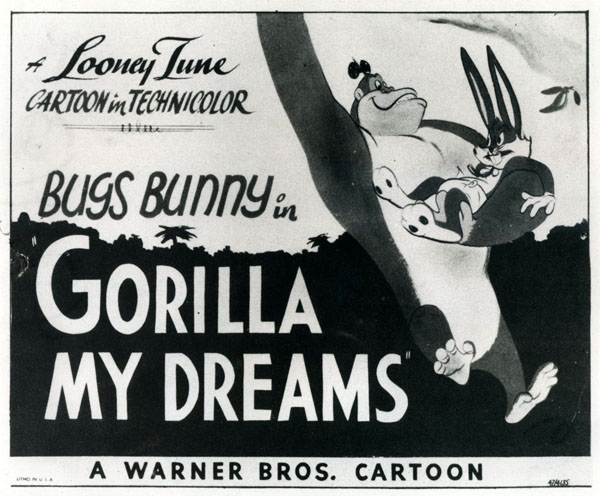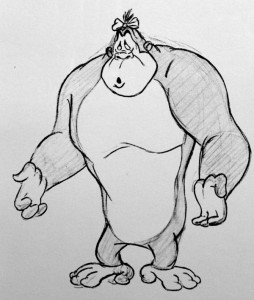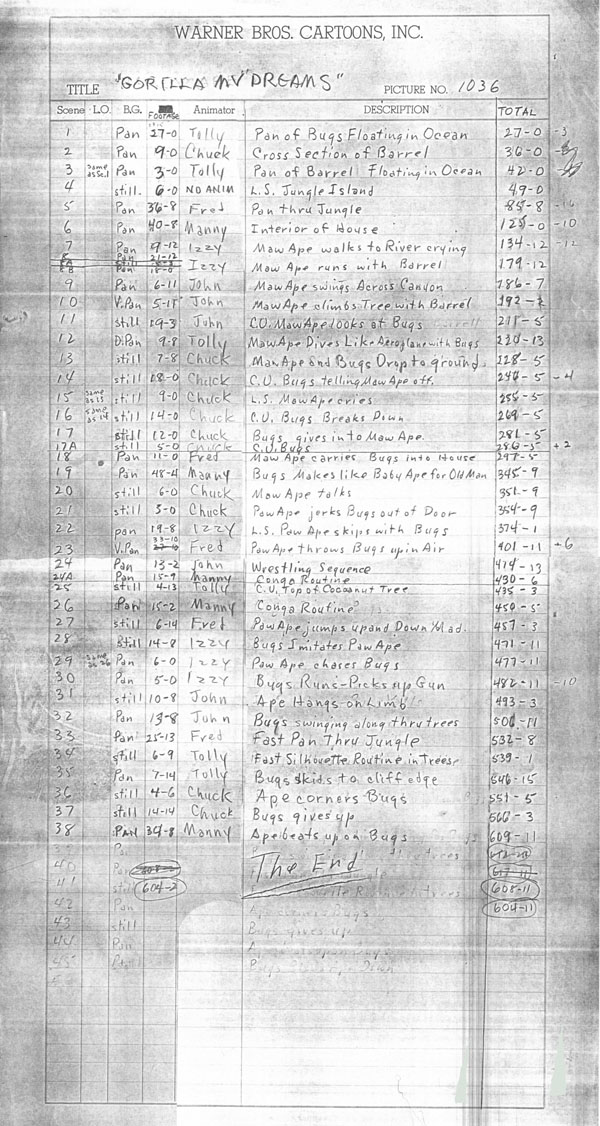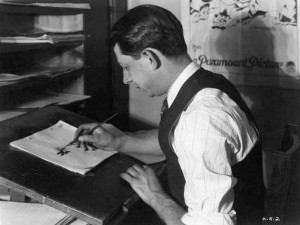
Gather ‘round, folks! It’s a Bugs Bunny jungle “pitcher”!
Precarious journeys in a mysterious jungle proved successful in newsprint and screen throughout the first half of the 20th century, as made popular by Edgar Rice Burrough’s Tarzan of the Apes. Many adventures featuring such characters as Jungle Jim, Bomba the Jungle Boy and Congo Bill followed in its wake. The tropical wilderness, supplied by layout artist Cornett Wood and background artist Richard Thomas, is one of the many standout elements in this cartoon. The layout in scene 34, in particular, is visually striking.
By the time Gorilla’s story work commenced in late 1945, with voice recording held on January 19, 1946, the post-war baby boom emerged into American society. An impressive amount of children were born over the next three years — a considerable difference from the birth rates from the previous decade. Mrs. Gorilla’s depression over her incomplete family, and the dark twinge in the story where she contemplates suicide by a nearby river, could easily allude to these specific events. Her “gruesome” husband, repulsed with the notion of having children, certainly doesn’t help matters.

Bugs’ design is remarkably different in this cartoon. This new design, with its small cranium, slight pot-belly and big jowls, appeared up until 1950’s Hurdy-Gurdy Hare. Though several animation lovers have rebuked it, this Bugs has its share of fans. Female staffer Jean Blanchard designed this plump version of Bugs, and her scheme undeniably benefited the joyously obnoxious nature of Bob McKimson’s ‘40s cartoons. Blanchard left the studio around 1947, and later worked at MGM. She also drew caricatures of the staff for the in-house Warner Club News magazine. One big question about her career at the studio — did Blanchard animate for the McKimson unit? It remains a mystery for now.
McKimson’s brother Charles – credited as “Chuck” in the draft, started at Warners in 1937, in Tex Avery’s unit, but left the studio to serve in the Army Signal Corps during WWII. He returned around 1946 and was naturally assigned to his brother’s crew. Chuck’s drawing/animation is very similar to his brother’s and he was often assigned close-ups in the McKimson cartoons. While he animated at Warners, Chuck – under the pseudonym “Al McKimson” — drew the syndicated Roy Rogers comic strip from 1949-53, with his brother Tom and background artist Pete Alvarado.
When Warners briefly closed its animation division in the wake of the 3-D craze in 1953, Chuck joined Dell Publishing and became an art director for their comics and coloring books. He left in 1960 to work as an animation director for Calvin and the Colonel (1961-62), an offshoot of the Amos n’ Andy radio/television program that only ran for one season. After Calvin’s cancellation, Chuck created title sequences for features and television programs at Pacific Title.
Manny Gould’s expansive animation is easily the strongest work in Gorilla. His knack for comedic acting used broad arm gestures (instigated by McKimson’s direction), and foreshortening characters directly toward the camera. First named Emmanuel Goldman, Gould began his animation career at Fleischer’s Inkwell studio, alongside Dick Huemer, Burt Gillett, Sid Marcus and Ben Harrison. Fleischer accused them of infringement of the “secret process” used in producing the series, so they left and formed Associated Animators – not to be confused with the early union created by John Terry and Bill Nolan to fight the Bray/Hurd cel patent — animating on cartoons starring Mutt and Jeff, released from 1925-26.
In 1927, Gould and Harrison supervised the Paramount Krazy Kat studio in Manhattan after Bill Nolan was dropped from the series. The two animated/directed under producer Charles Mintz for several years and moved to the West Coast after the studio changed distributors from Paramount to Columbia. Gould and Harrison, along with Marcus and Huemer, left Mintz over a salary dispute around 1933. All but Huemer eventually returned. Gould continued to direct under Mintz and Screen Gems, but was fired during the big 1941 layoff that occurred while the studio was being reorganized.Gould went over to Warners, first animating under Bob Clampett and then in McKimson’s unit. He left in 1947 to work with Jerry Fairbanks on Paramount’s Speaking of Animals series. After a large gap in the ‘50s, Gould’s credits resurface around the late ‘60s, when he animated on Ed Graham’s Linus the Lion Hearted television series. He spent a majority of his career at DePatie-Freleng, where he frequently animated his scenes at home, since he suffered from cancer. Gould also worked on Ralph Bakshi’s Heavy Traffic, Abe Levitow’s B.C. Thanksgiving special and the late Bob Taylor’s Nine Lives of Fritz the Cat. It is unclear as to his views over his shift from supervisory role to regular animator in the later years, since he passed away the week Milt Gray intended to interview him in 1975.
 John Carey’s scenes in the cartoon suffer from shoddy clean-up/inking, but his scene 11, with Bugs’ reaction to suddenly being high up in a tree, has some unique and funny drawings. Scene 31, where Gruesome lets go of a tree limb during a take, while anticipating a fall before the next dissolve, is hysterical. Carey started his career at Ub Iwerks’ studio and was part of the group of artists that switched over to the “Katz unit” for Bob Clampett. Schelesinger signed his contract on June 21, 1937. He animated for Clampett and Norm McCabe until he left for his service in the Navy during World War II. He returned to Warners in the mid-‘40s, animating in the McKimson unit, but left in the early ‘50s to become an artist for Dell Comics. Carey drew licensed Warners and Lantz characters, and moved onto Hanna-Barbera and Disney stories in the ‘60s. Later, he illustrated many Winnie the Pooh stories written by Vic Lockman, until his 1984 retirement.
John Carey’s scenes in the cartoon suffer from shoddy clean-up/inking, but his scene 11, with Bugs’ reaction to suddenly being high up in a tree, has some unique and funny drawings. Scene 31, where Gruesome lets go of a tree limb during a take, while anticipating a fall before the next dissolve, is hysterical. Carey started his career at Ub Iwerks’ studio and was part of the group of artists that switched over to the “Katz unit” for Bob Clampett. Schelesinger signed his contract on June 21, 1937. He animated for Clampett and Norm McCabe until he left for his service in the Navy during World War II. He returned to Warners in the mid-‘40s, animating in the McKimson unit, but left in the early ‘50s to become an artist for Dell Comics. Carey drew licensed Warners and Lantz characters, and moved onto Hanna-Barbera and Disney stories in the ‘60s. Later, he illustrated many Winnie the Pooh stories written by Vic Lockman, until his 1984 retirement.
Anatolle Kirsanoff and Izzy Ellis are uncredited for their Gorilla animation. Kirsanoff is given four scenes in the cartoon, but Ellis has a considerable amount of footage. Ellis is credited in later McKimson productions (Daffy Duck Slept Here and Hop, Look and Listen, released in ’48), but he might have left Warners by the time either of those two were in production ─ hence the lack of credit. There is a credited “Fred” in the draft for this cartoon that is finally confirmed as Fred Abranz, not Fred Jones as was previously thought in Birth of a Notion.
To reiterate, Fred Jones left Disney on February 1947, after Gorilla finished animation, so it seems more likely that Abranz was the one standard “Fred” in the McKimson unit. Michael Barrier’s copy of the Notion draft does not include the “Fred Jones” notation like the copy embedded in the breakdown posted in April. That information was relayed from the late Martha Sigall who thought Jones was the credited “Fred”. Further evidence has surfaced that Abranz was also one of the many staffers shown on a Christmas-greetings page by the cartoon department in the January 1945 issue of Warners Club News.
 Abranz spent most of his career as an assistant animator, but briefly animated at Warners, which might have led to his absence in the main credits. He claimed that he found animation to be too demanding, and felt more comfortable as an assistant. Abranz’s work as a regular animator was more than competent, as previously seen in Birth Of A Notion and Hot Cross Bunny. The cycle of Gruesome angrily pounding his chest in scene 23 — reprised with slower exposures in sc. 27 — is wonderful.
Abranz spent most of his career as an assistant animator, but briefly animated at Warners, which might have led to his absence in the main credits. He claimed that he found animation to be too demanding, and felt more comfortable as an assistant. Abranz’s work as a regular animator was more than competent, as previously seen in Birth Of A Notion and Hot Cross Bunny. The cycle of Gruesome angrily pounding his chest in scene 23 — reprised with slower exposures in sc. 27 — is wonderful.
Like Chuck and Carey, he left the studio around 1950 to become a staff artist for Western Publishing’s Dell Comics, illustrating stories and Little Golden Books with the Warners characters. Abranz also drew comics for Lantz’s Woody Woodpecker and Andy Panda, as well as Disney’s Little Hiawatha and Big Bad Wolf. At first, he served as a penciller, letterer and inker on his comic pages, but grew tired of the second half of the process and eventually did only the drawing. Near the end of his career at Dell, he wrote his own comic stories. In the early ‘60s, he focused on the Hanna-Barbera characters, but as the story format decreased in page length, he moved on to become an artist for Disney’s comics intended for overseas publications. Abranz continued to work for Western, drawing stories for Little Monsters and The Cave Kids, until he retired from comics in 1967, returning to animation. Abranz served as an assistant animator, in the ‘70s and early ‘80s, for Ralph Bakshi, Ruby/Spears and Warner Bros.’ Looney Tunes revival features.
Carl Stalling’s scoring session for Gorilla was held in late January 1947. It’s ambiguous as to the delay from its January 3, 1948 release, unless there was a backlog of completed productions. Nevertheless, it’s fascinating to notice the gestation that different Warners cartoons endured. This cartoon houses arguably one of Stalling’s finest musical soundtracks for the studio. His usage of Raymond Scott’s Dinner Music for a Pack of Hungry Cannibals during the climatic chase between Bugs and Gruesome is marvelously frenetic. Besides the jaunty snatches of Congo, a trademark Stalling jungle favorite and Hey Doc, which plays when Bugs chatters like an ape for his new gruesome “daddy,” the music serves another type of mood and emotion throughout Gorilla. For instance, Ivanovicki’s Romanian waltz Danube Waves plays in the underscore during Mrs. Gorilla’s melancholic state. Even Bugs’ renditions of Trade Winds and Someone’s Rocking My Dreamboat, two hit songs from the early ‘40s, are a lovely treat in this cartoon.
Quit monkeying around and enjoy the breakdown video!

(Thanks to Michael Barrier, Milt Gray, Keith Scott, Yowp and Mark Kausler for their help.)



 DEVON BAXTER is a film restoration artist, video editor, and animation researcher/writer currently residing in Pennsylvania. He also hosts a
DEVON BAXTER is a film restoration artist, video editor, and animation researcher/writer currently residing in Pennsylvania. He also hosts a 





















































































Another of my Bugs Bunny Favorites! Love how Mel Blanc did all the voices (Bugs, and Mr and Mrs Gruesome Gorilla) and I’m still amazed on how Bugs received such a beatdown by Gruesome and survived resulting on Gruesome KOing himself by exhaustion after giving Bugs such a brutal beatdown! Also there was a remake of Gorilla My Dreams called Apes of Wrath (A play on words on Grapes of Wrath) directed by Friz Freling ans featuring June Foray as the mother gorilla.
LOL! I was just about to mention Mel Blanc as Mrs.Gruesome Gorilla and mention how brilliant that was. McKimson seemed at this period to (in order to svae money obviously, and maybe as there really weren’t many female lines in these shorts) have Mel do those (and the other time, “The Up-Standing Sitter”, which was even more lower budget, being in Cinecolor. “Upstanding Sitter” had a hen who hired Daffy who didn’t appear for more than 15 second, so bringing Mel in was an obvious no-brainer. Lowering “Upstanding Sitter”‘s cost even MORE was the the bulldog there was MUTE, not even a bark.Maybe an article on that one, and on Blanc doing fem,ales could be in order..)SC
“Carl Stalling’s scoring session for Gorilla was held in late January 1947. It’s ambiguous as to the delay from its January 3, 1948 release, unless there was a backlog of completed productions.”
Ha ha! Are there any 1946-1954 Looney Tunes and Merry Melodies actually released during the same calender year as their completion and copyright dates? Granted, they did rush them to theaters during the earlier war years, mostly because their “topical” nature would render them old before their time. Yet I think cartoons (MGM’s were stockpiled too) and two-reel comedies (many Three Stooges comedies took a year to reach theaters as well, post-war) were left “on the shelf” longer than, let’s say, a sports-reel (like Fox’s Movietone Sports Review, etc.) because theater owners could care less if it was “old” as long as it was “new” to theaters. Also, I read in vintage magazines like BoxOffice that Technicolor often got behind in the 1940s, so many color shorts and features took longer than the B&W stuff. (That is where Warner’s Cinecolor period fits in, aside from being a cost-cutting measure.)
One popular theory… and somebody can correct me here… is that the Warner cartoon shut-down in 1953 probably had less to do with the 3-D craze and more to do with too many shorts sitting on the shelf. Most in release that year was completed n 1951. In addition, there were all of those “Blue Ribbon” reissues making just as much profit.
Another McKimson Masterpiece. Thanx, Devon.
Add me to the list of fans of Blanchard’s designs.
The ending seems abrupt in this picture and the route sheet boasts seven more scenes at the end that seem to have been erased. Did McKimson not have enough footage to include those scenes or were they cut after being animated?
The descriptions for the “erased” scenes 39-45 appear to match the last few scenes remaining in the draft 32-38), but with a couple of differences. There’s no match for scene 35, “Bugs skids to cliff edge”, and scene 38 has been broken up into scene 44 and 45 – “Ape beats up on Bugs” (same description as scene 38) and “Bugs Blows Ape Down”, which in the final cartoon is part of scene 38.
So, it doesn’t look like anything was taken off the end, just some scenes combined into single shots. (And maybe some scenes taken out from earlier in the cartoon, with the later scenes accordingly “moved up” the draft)
It looks like some scenes were cut for time. Going by the lowest footage total on the right hand side of the page (604′ 11x), it calculates out to almost 7 minutes (630 feet), not factoring the footage used for the WB bullseye, credits and closing. The release time (according to IMDB) is 7 minutes so McKimson probably had enough of an overage for editing and didn’t need the extra footage.
The reason why the ending seems abrupt may not be the ending itself but the unusual story structure. When Bugs is introduced to his Ape “Daddy”, and the ape drags him outside, it looks like the start of the story, but the cartoon is already half way over. When the ape catches up with Bugs at the edge of the cliff, it’s only been three minutes since the story began, so it feels like time for another big setpiece… but instead, we get an ending.
Personally I like this unusual structure – it breaks the cartoon up a bit more nicely than the “spot-gag” formula which would prevail in later years.
I, too, like Jean Blanchard’s design of Bugs, and it fits when you see him dressed in baby clothes, pink no less, if I remember correctly! As for point of view takes in “GORILLA MY DREAMS”, you just cannot beat (no pun intended) the precursor take just before Bugs is about to be given the beating of his life by his new “daddy”. We are looking at Bugs from Gruesome’s point of view, with those big hammy “hands” advancing on Bug’s throat from the left and the right be fore he is whisked offscreen…and that reaction shot of Bugs as Gruesome lets out a growl is also fantastic!
Interesting scene of Ellis’ when the mother gorilla runs off with the barrel. This is a remarkably complicated layout, or series of layouts intended to look like one scene, quite successfully.
Also, do you suspect that Abranz was Charles MdKimson’s assistant, or maybe even Bob McKimson’s assistant even earlier? The drawing and approach are so similar.
The lengths and descriptions of scenes 8-10 in the draft don’t quite match those we actually see, so I’m not sure we can be certain how much of that sequence is Ellis and how much is Carey.
YOU SHALL DO Mouse Wreckers NEXT
I don’t think Devon has access to any CHUCK JONES drafts 😉
Say, what’s the piece of music that’s playing at 4:05, as “Baby” Bugs torments Gruesome? It’s one of those Stalling favorites, like “In a Melancholy Mood,” that isn’t revived today. I once heard a flautist play her arrangement of this piece. When asked, she said she transcribed it from Warner Brothers cartoons. (She didn’t know the tune’s title, either.)
I think Devon identifies that piece of music as “Hey Doc”. I remember it also appears in “The Hare-Brained Hypnotist”.
Is “Krazy Kat Studio” really an official name of that studio? It seems to me that it’s properly referred to as the Winkler Pictures studio.
Another dream come true! Always wanted to know how much of this cartoon was animated by Manny Gould!
Great post as always, Devon!
Analysing these McKimson drafts..it’s interesting to see how he assigns scenes to his animators. He doesn’t usually give sequences in continuity for animators to do..which is very common in a lot of Hanna-Barbera’s “Tom and Jerries”. I suppose it’s a strategy to split footage to his animators in order to meet their quotas..
Manny Gould’s animation in general is overanimated, but it works on so many levels. A top notch job on Bugs mimicking a gorilla’s instincts! As for Kirstanoff, Phil Monroe mentioned in Mike Barrier’s interview, that each unit had “A” animators and “B” animators. Is it possible, Kirstanoff was a “B” – hence his lack of credit?